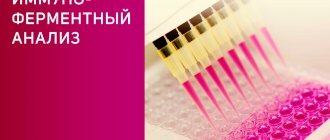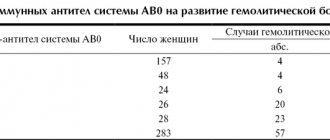Complexes with this research
Future dad Comprehensive examination to prepare a couple for conception 4,990 ₽ Composition
Expanded hospital complex Expanded infectious screening for prevention and hospitalization 4,270 ₽ Composition
Preparation for IVF for a man Examination to prepare a man for the IVF procedure 3,710 ₽ Composition
IN OTHER COMPLEXES
- Pregnancy planning. Clinical indicators RUB 3,620
- Joining IVF RUB 14,350
- Examination during pregnancy. 1st trimester 9,770 RUR
Rh factor when planning pregnancy
The Rh factor is also important when planning pregnancy. If a man has a positive Rh factor and a woman has a negative Rh factor, then in most cases their child will have a positive Rh factor. That is, a situation arises when the mother is Rh-, and the fetus is Rh+. In this case, there is a risk of conflict regarding the Rh factor during pregnancy. This situation requires special attention during pregnancy. It will be necessary to take tests to determine the titer and class of anti-Rhesus antibodies in the blood.
Normally, the mother’s blood and the baby’s blood do not mix during pregnancy, since there is a placental barrier. Therefore, antigen D does not enter the mother’s blood, and antibodies to it are not produced. Therefore, the first pregnancy with a conflict regarding the Rh factor, as a rule, proceeds without complications. However, during childbirth, the genital tract is injured, and the baby’s skin may also be damaged, which means there is a high probability of the antigen entering the mother’s blood. Sensitization of the mother's body occurs, and now the next pregnancy may be complicated. The risk of sensitization during childbirth by cesarean section is especially high. If the first pregnancy was artificially terminated (abortion) or ended in miscarriage, then the risk of maternal sensitization also increases.
In some cases - with diabetes mellitus, preeclampsia, influenza or ARVI suffered during pregnancy - the fetal protection is weakened, and the process of antibody production begins during the gestation period.
If antibodies are already present in the mother's blood, during a new pregnancy they can penetrate the placental barrier and have a detrimental effect on the condition of the fetus (hemolytic disease of the fetus). Under the influence of antibodies, the child’s red blood cells begin to destroy, which leads to damage to the liver, kidneys, and brain. The likelihood of miscarriage increases.
Timely treatment for Rh conflict can significantly reduce the risk of developing the most severe complications of hemolytic disease.
The risk of a conflict due to the Rh factor is not a contraindication for pregnancy and cannot be a reason to terminate it.
Detailed description of the study
The formed elements of human blood - red blood cells - may have some markers on their surface, called antigens.
There are two main such antigens - A and B. Based on their presence, 4 blood groups are distinguished: O(I) - absence of antigens A and B on the surface of the cell A(II) - antigen A is present on the surface of the erythrocyte B(III) - present on the surface of the erythrocyte antigen B AB (IV) - both antigens are found on the surface of the erythrocyte
These antigens have no physiological role, but determine the compatibility of blood during transfusion. When incompatible blood is transfused, an immune reaction of rejection of the foreign protein develops, which leads to the destruction of red blood cells - hemolysis.
Another marker of blood compatibility during transfusion is the Rh factor. This is a protein that is produced in 85% of Caucasians and 99% of people of the Mongoloid race. It is present on the surface of red blood cells, but does not play a significant role in the life of the body.
When blood containing the Rh factor enters the bloodstream of a person who does not have this protein on the surface of red blood cells, the human immune system perceives it as foreign. As a result, hemolysis develops. Therefore, blood transfusion requires taking into account compatibility not only by blood group, but also by the Rh factor.
It is especially important to know your Rh status for women planning a pregnancy. If a woman with no Rh factor becomes pregnant with an Rh positive man, there is a chance that the child will also have an Rh factor.
In such a case, antibodies to the Rh factor may appear in the mother, which will cause hemolysis of the fetus, which is called Rh conflict. The formation of these antibodies can occur when fetal blood enters the mother's bloodstream. Factors that increase the risk of Rh conflict are:
- Complications of a previous pregnancy in the early stages (ectopic pregnancy or its termination);
- Abdominal injury during pregnancy;
- Vaginal bleeding during pregnancy;
- Medical interventions during pregnancy that require the removal of cells or fluid from the amniotic sac, such as amniocentesis and chorionic villus sampling.
With increasing gestational age, the risk of developing Rh conflict increases. Its appearance in the first trimester leads to missed pregnancy and its early loss; in the case of late Rh conflict, premature birth is possible. The newborn has hemolytic jaundice, which is accompanied by damage to internal organs and requires treatment.
It is important that antibodies to the Rh factor take time to form. Often the first pregnancy with Rh conflict proceeds favorably, since the immune system is just beginning to produce antibodies. The risk of complications in the second and subsequent pregnancies is much higher.
Studying your blood group and Rh factor helps you avoid complications associated with blood transfusions. With regard to the Rh factor, its determination is also important for assessing the risk of Rh conflict during pregnancy.
What is Rh factor
By the middle of the 20th century, scientists received confirmation that the compatibility of people according to the immunological characteristics of blood is not limited to the classical division into four blood groups. A protein was discovered that is present in the blood of approximately 85% of people. Accordingly, approximately 15% of people do not have it. When blood is transfused from the first to the second, the recipient’s body begins to produce antibodies to this protein, that is, this substance is an antigen. In medicine, this protein is designated by the Latin letter D. If protein D is in your blood, it means that you have a positive Rh factor (Rh+)
, and you belong to the majority (85%).
If this antigen is not in your blood, your Rh factor is negative (Rh-)
. The Rh factor does not change throughout life.
Is it possible to get pregnant if partners have different Rhesus numbers?
Different Rh factors of partners do not affect the possibility of conception. However, Rh conflict, which may develop subsequently, jeopardizes pregnancy and childbirth. Therefore, when planning conception, it is recommended to determine the Rh factors of partners in order to know in advance about the possible risk.
As a rule, the first pregnancy in such couples passes without complications. While antibodies have not yet been developed in the woman’s blood (this takes time), Rh conflict with the fetus does not develop. If the expectant mother has previously had Rh-incompatible pregnancies, that is, the mechanism for the formation of antibodies has already been launched, they will begin to be produced very quickly.
With each pregnancy, the number of antibodies in the blood increases. The likelihood of Rh conflict also increases if there have been previously interrupted or ectopic pregnancies, as well as blood transfusions. Therefore, no later than 3 days after termination of pregnancy or blood infusion, women with a negative Rh factor are injected intramuscularly with human anti-Rhesus immunoglobulin. This will minimize the risk of complications in the future - during the next pregnancy.
Pregnant women with a high risk of Rh conflict must be monitored by doctors: the woman must regularly undergo a blood test, which allows monitoring the presence of antibodies to fetal red blood cells. It is now common practice in many countries to give an injection of anti-Rhesus immunoglobulin at 28 weeks for most Rh-negative women. Sometimes this procedure is repeated at 32 weeks.
Method for performing a reaction in a test tube without heating
1. Add one drop of the anti-Rhesus reagent Rh0(D) to the bottom of the test tube.
2. Add one drop of red blood cells to be analyzed to the contents of the test tube.
3. Shake the tube to mix the liquids.
4. Tilt the test tube to an almost horizontal position and rotate it around the vertical axis at low speed for at least three minutes. The distribution of red blood cells along the walls contributes to more pronounced results of the reaction.
The result of the agglutination reaction usually appears within the first minute of interaction of the test blood with the universal reagent. In this case, the analyzed blood samples should be in contact with Rh0(D) for at least three minutes: a delayed onset of agglutination is possible in the presence of a weak Du antigen.
5. Add 2 - 3 ml of isotonic NaCl solution and invert the test tube 2 - 3 times without shaking. Sodium chloride eliminates the manifestation of nonspecific agglutination.
6. Evaluate the result of the reaction visually. Pronounced agglutinates against the background of clear liquid indicate the presence of antigen D, evenly colored liquid without red blood cell aggregation is evidence of Rh-negative blood.
The result of determining the Rh factor using the express method is reliable only if the reaction of the universal reagent is positive with standard erythrocytes Rh+ and negative with test erythrocytes Rh-.
Blood type and Rh factor
A comprehensive study that allows you to assess whether a patient’s blood belongs to one of the groups according to the ABO system and determine the presence/absence of the Rh antigen.
What is this analysis used for?
- To determine whether a person’s blood group belongs to one of the groups according to the ABO system and the Rh system.
When is the test scheduled?
- When transfusing blood components to a recipient;
- when donating blood by a donor;
- in preparation for surgical operations;
- when planning pregnancy or during it;
- if fetal erythroblastosis is suspected;
- in preparation for transplantation of bone marrow, kidney, liver and other organs and tissues;
- when persons enter military service, into the ranks of the Ministry of Emergency Situations and other law enforcement agencies.
Synonyms Russian
Blood group according to the ABO system, Rh factor.
English synonyms
Blood typing, ABO group, Rh type.
Research method
Agglutination reaction.
What biomaterial can be used for research?
Venous blood.
How to properly prepare for research?
- Eliminate fatty foods from your diet for 24 hours before the test.
General information about the study
Each person has a unique combination of antigens on the surface of their cells, including red blood cells. To date, more than 250 erythrocyte antigens are known, forming about 30 antigenic systems. Clinically, the most important of them are the ABO system and the Rh system.
The ABO system is the main blood compatibility system. It is represented by agglutinogens A and B, which are glycoproteins located on the surface of red blood cells, and agglutinins alpha and beta, which belong to the class of IgM immunoglobulins and circulate in the blood plasma. Depending on the combination of these agglutinogens and agglutinins, 4 blood groups are distinguished according to the ABO system.
The first (I) blood group (the most common in the European population, 42% of the population) is also called O-group, in which agglutinogens A or B are absent on the surface of red blood cells, agglutinins alpha and beta are detected in the plasma.
The second (II) blood group (37%) is also called A-group; agglutinogen A is present on the surface of red blood cells; agglutinin beta is detected in the plasma.
The third (III) blood group (13% of the population) is also called B-blood group; agglutinogen B is present on the surface of red blood cells; agglutinin alpha is detected in the plasma.
The fourth (IV) blood group (the rarest, only 8% of the population) is also called AB blood group; agglutinogens of both types A and B are present on the surface of red blood cells; agglutinins alpha and beta are absent in the plasma.
The Rh system also consists of several antigens, the main one of which is called antigen D, or Rh factor. In approximately 85% of people, the Rh factor (Rh-positive blood) can be detected on the surface of red blood cells.
The belonging of a person’s blood to a certain group according to the ABO system and the Rh system is genetically determined and does not change throughout life.
Determining the blood group and Rh factor is of greatest importance when preparing for blood transfusion. Such a need may arise in case of severe blood loss, severe forms of hemolytic anemia, bone marrow diseases with disruption of normal red blood cell production, as well as during major surgical operations. The blood group according to the ABO system and the Rh system is taken into account not only when transfusing red blood cells, but also when transfusing other blood components (platelet mass, leukocyte suspension, etc.). Blood group determination is a mandatory test during pregnancy. In this case, data on the patient’s blood group and, in some cases, on the blood group of the child’s father are taken into account for timely diagnosis and treatment of an immunological conflict (caused by the incompatibility of the blood of the fetus and mother) and the resulting hemolysis of fetal red blood cells. Military personnel, soldiers of the Ministry of Emergency Situations and other law enforcement agencies are also subject to mandatory examination for blood type and Rh factor.
It should be noted that in clinical practice, several methods are used to confirm the compatibility of the blood of the donor and recipient, including separate laboratory determination of the blood group of the donor and recipient, a test for the individual compatibility of the donor’s red blood cells and the recipient’s serum, and a biological test. These measures are carried out because the probability of error in laboratory determination of blood group is small, but still exists.
Since the laboratory method for determining blood groups is based on the agglutination reaction, the presence in the patient’s serum of specific proteins (M-protein, cold antibodies) or some bacteria that interfere with this reaction can lead to false-positive or false-negative results. Also, taking certain medications may affect the results of determining the Rh factor. Therefore, special attention should be paid to preparing for the test.
What is the research used for?
To determine whether a person’s blood group belongs to one of the groups according to the ABO system and the Rh system.
When is the study scheduled?
- When transfusing blood components to a recipient;
- when donating blood by a donor;
- in preparation for surgical operations;
- when planning pregnancy or during pregnancy;
- if fetal erythroblastosis is suspected;
- in preparation for transplantation of bone marrow, kidney, liver and other organs and tissues;
- when entering military service, the ranks of the Ministry of Emergency Situations and other law enforcement agencies.
What do the results mean?
| Results of blood group determination using the ABO system | |||
| Agglutinogens on the surface of red blood cells | Agglutinins in blood serum | Blood type, designation in Roman numerals | Blood group, designation in Latin letters |
| None | alpha and beta | I | O |
| A | beta | II | A |
| IN | alpha | III | B |
| AB | None | IV | AB |
| Results of determining the Rh factor | |
| Rh factor on the surface of red blood cells | |
| Found | Rh positive blood, Rh |
| Not found | Rh negative blood, Rh- |
What can influence the result?
- The presence of specific proteins (M-protein, cold antibodies) or certain bacteria in the patient's serum may interfere with the agglutination reaction used in the test.
- Taking certain medications (levodopa, methyldopa) can lead to false-positive Rh factor test results.
- The results of the analysis of a blood sample in the presence of hemolysis are unreliable.
Important Notes
- To obtain an accurate result, you must follow the recommendations for preparing for the test.
- The belonging of a person’s blood to a certain group according to the ABO system and the Rh system is genetically determined and does not change throughout life.
Also recommended
- Complete blood count (without leukocyte formula and ESR)
- Erythrocyte sedimentation rate (ESR)
- 4 required tests
- Screening for multiple myeloma and paraproteinemias (immunofixation of blood serum with pentavalent serum)
Who orders the study?
Surgeon, therapist, hematologist, general practitioner, transfusiologist.
Literature
- Hosoi E. Biological and clinical aspects of ABO blood group system. J Med Invest. 2008 Aug;55(3-4):174-82.
- Agre P, Cartron JP. Molecular biology of the Rh antigens. Blood. 1991 Aug 1;78(3):551-63.
- Chernecky CC Laboratory Tests and Diagnostic Procedures / S.S. Chernecky, V.J. Berger; 5th ed. — Saunder Elsevier, 2008.
Conducting a conglutination reaction with gelatin
The reaction is carried out using the standard anti-Rhesus reagent Rh0(D) or the anti-Rhesus reagent Anti-D.
1. Add approximately 0.05 ml (one drop) of the blood being tested or 50% of the red blood cell suspension in the serum into the test tube.
2. Heat the 10% gelatin solution to a liquid state.
3. Add 0.1 ml (two drops) of gelatin to the blood sample being tested.
4. Add 0.1 ml (two drops) of Rh0(D) anti-rhesus reagent or Anti-D coliclone.
5. Stir the contents.
6. Warm the test tube in a water bath at 37 °C for 10 minutes.
7. Add 5 – 8 ml of NaCl solution.
8. Mix the liquids by carefully inverting the test tube 1 – 2 times.
9. Assess the result of the reaction with the naked eye; the use of a magnifying glass is allowed.
Clearly expressed aggregates of various sizes against the background of a clear solution indicate the detection of antigen D; a uniformly colored liquid without the presence of agglutinates is a sign of the absence of an agglutinogen.
10. Confirm the reliability of the study with a control determination.
The results are reliable if the anti-Rhesus reagent (anti-D coliclone) gives a positive reaction result with Rh+ test erythrocytes, a negative reaction with Rh-, and gelatin does not agglutinate the analyzed blood sample in the absence of anti-D antibodies.
If the results of the control study are inadequate, repeat the determination of the Rh factor using the express method, replacing the typing reagent and/or gelatin. In case of fine-grained agglutination, conduct an additional study of red blood cells in the indirect Coombs reaction.








